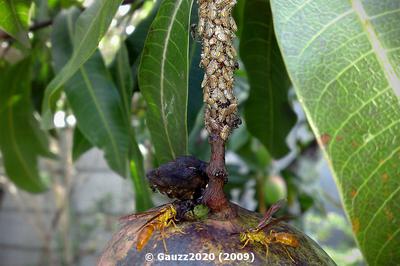Mango Hoppers
Idioscopus spp.
Insect
In a Nutshell
- Leaves, flower and twigs turn brown and dry up.
- Hoppers produce honeydew.
- Hopper are golden or dark brown, wedge-like shape with broad, round head and globular eyes.
Can also be found in
Symptoms
Nymphs and adults of Idioscopus species suck phloem sap from twigs, inflorescences, tender leaves and fruits. Affected plant tissue turns brown, and may deform and dry up. Young flowers fail to develop, thereby influencing fruit set and development. While feeding on mango trees the hoppers produce sugary fluids (honeydew) that attract other insects and present an ideal culture medium for the growth of sooty mold. The fungal growth on leaves affects photosynthesis, impacting tree vigor and reducing its productivity. Mango hoppers lay their eggs into the leaves and flower stems of mango trees, which may also cause damage to the tissues. Mango hoppers can become a serious pest, with crop losses of up to 50%.
Recommendations

Organic Control
Biological control agents such as the predators Mallada boninensis and Chrysopa lacciperda and the egg parasite Polynema sp. can reduce hopper populations. Alternatively, affected mango trees can be treated with oil-based sprays containing the fungi Beauveria bassiana or Metarhizium anisopliae. Treatment at rates of 2-3 times per week is recommended. Sprays based on neem oil (3%) can also reduce Idioscopus spp. populations by up to 60%.

Chemical Control
Always consider an integrated approach with preventive measures together with biological treatments if available. Use sprays containing cypermethrin (0.4%), these have proven highly effective. Insecticides containing dimethoate can be injected into the trunk. Two sprays, 7 days apart, are recommended before the beginning of flowering, thereby reducing side effects on pollinators.
What caused it?
Mango leafhoppers usually feature a wedge-like shape with a broad, round head, and globular eyes. Adults are golden or dark brown and about 4-5 mm long. Nymphs are yellow-brown, with red eyes. Mango hoppers lay their eggs singly in the florets, leaf veins and leaf lamina, depending on the species. Between 100 and 200 eggs may be laid. They prefer shade environments with high humidity. Adult hoppers are good fliers and spread rapidly over short distances. Transport of nursery plants may spread the insects to other orchards or areas. Old, neglected or closely planted orchards are favorable for their multiplication.
Preventive Measures
- Keep a wide distance between trees when planting.
- Regularly monitor the orchards for nymphs and adults of Idioscopus species.
- Chose varieties which are less susceptible to mango hoppers.
- Do not transport infected mango plants between orchards.



